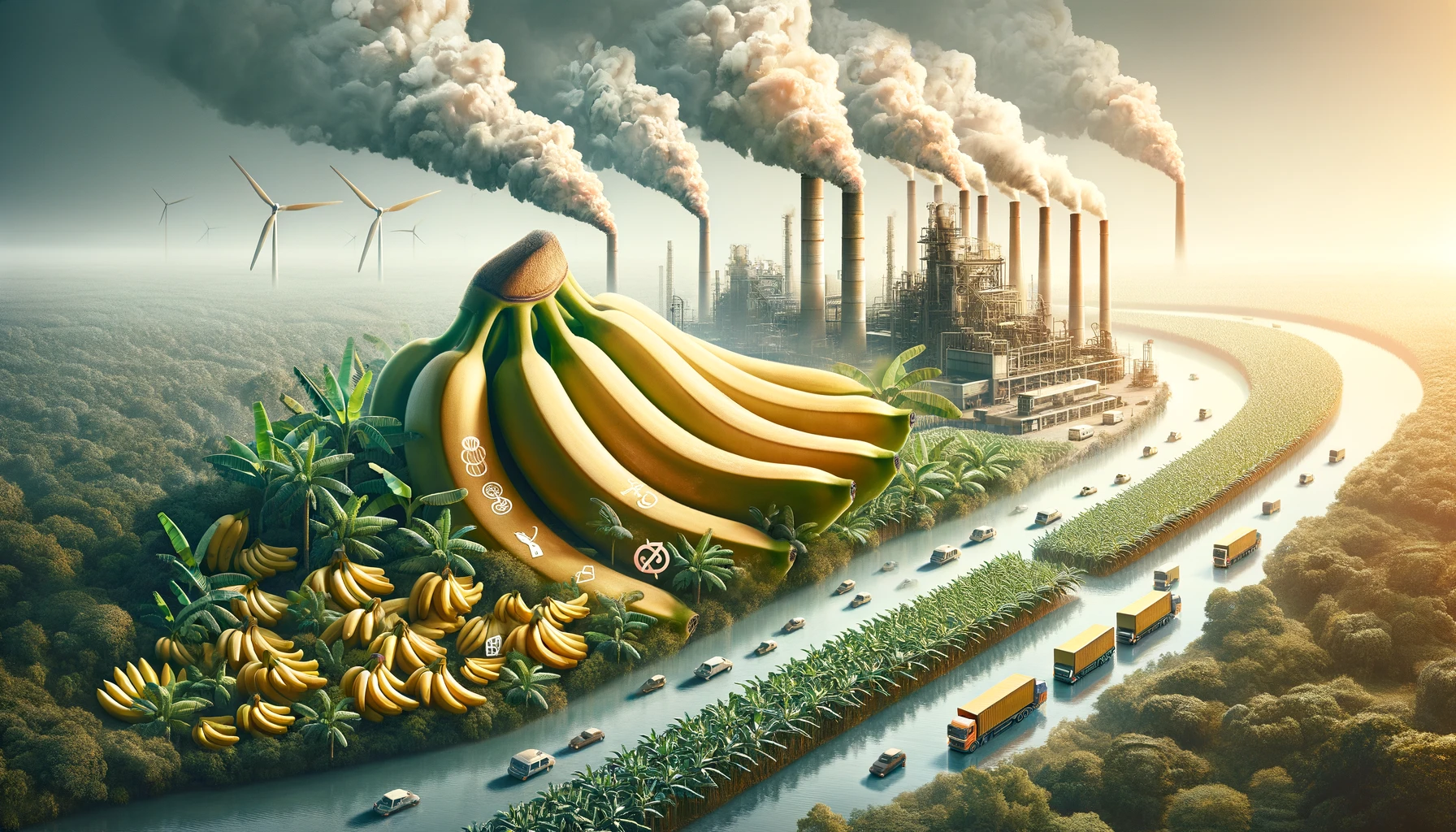Bananas are inexpensive, delicious, and loved around the world.
However, their production and distribution are accompanied by various environmental impacts.
INDEX
Environmental Impacts of Banana Production
Deforestation
Deforestation is carried out in tropical regions such as rainforests and savannas for banana cultivation.
Deforestation causes global warming and biodiversity loss.
As for the impact on global warming, deforestation may increase greenhouse gas emissions and accelerate global warming, since forests absorb sunlight and suppress greenhouse gases.
As for the impact on biodiversity loss, forests are home to many plants and animals, and deforestation has put many of them at risk of extinction.
Deforestation also reduces soil water retention capacity and quality, and increases the risk of flooding and landslides.
Soil Pollution
Bananas are grown using large amounts of fertilizers and pesticides.
This causes environmental problems such as soil and water pollution and disruption of the nitrogen cycle.
The use of fertilizers and pesticides leads to a decrease in the number of microorganisms and animals in the soil, which reduces the soil’s ability to retain water and nutrients.
In addition, components of fertilizers and pesticides leach into water and flow into rivers and lakes, causing water pollution.
Furthermore, the use of fertilizers and pesticides can lead to disruption of the nitrogen cycle, causing problems such as acid rain and ozone layer depletion.
Labor Issues
Banana cultivation and distribution require a lot of labor, but the banana industry is facing serious labor problems such as low wages, long working hours, and child labor.
Low wages and long working hours have a negative impact on workers’ health and livelihood, while child labor is a violation of children’s rights.
Long transportation distances
Bananas are one of the most environmentally hazardous foods because of the long transportation distances.
Most bananas imported to Japan are transported by air from South America and Southeast Asia.
Air transportation is a means of transportation that consumes a lot of fuel and emits large amounts of CO2.
In order to reduce CO2 emissions from air transportation, shipping or rail transportation may be used.
Spoilage and damage during transportation
Bananas are easily damaged fruits. Therefore, many bananas are discarded during the transportation and distribution process.
In order to reduce spoilage and damage during transportation, improvements in transportation and packaging methods are required.
Discard of Uneaten Bananas
Uneaten bananas are often discarded.
Food loss not only wastes food, but also increases environmental impact.
To reduce the amount of uneaten bananas, it is important to prevent over-buying and leftovers. Also, uneaten bananas should be frozen and eaten at a later date.
Disposal of Banana Peels
Banana peels are most often discarded, despite the fact that they contain many nutrients.
Banana peels can be used as fertilizer, animal feed, or biofuel.
Effective use of banana peels can reduce environmental impact.
How to reduce the environmental impact of bananas.
Keep local production for local consumption
Bananas are grown in Japan in warm regions such as Okinawa and Kagoshima.
By keeping in mind local production for local consumption, we can reduce the environmental impact of transportation.
Eat foods in season
Bananas are in season from summer to fall.
By eating foods in season, you can shorten transportation distances and reduce environmental impact.
Buy enough food to eat.
When shopping, buy only what you can eat.
Also, freeze bananas that you cannot finish and eat them at a later date.
Make effective use of banana peels
Banana peels can be used as fertilizer, animal feed, or biofuel.
Make effective use of banana peels instead of throwing them away.
Raise consumer awareness
It is also important for consumers to understand the environmental impact of bananas and take action to reduce it.
For example, eating foods in season, buying enough to eat, etc.
Bananas are a delicious and nutritious fruit.
However, its production and distribution is accompanied by various environmental burdens.
Each of us can do what we can to reduce our environmental impact.
Ranking of banana importing countries
According to the Ministry of Finance trade statistics for 2049, banana imports to Japan totaled approximately 1,045,000 tons.
The ranking by country is as follows.
| Country | Import Volume (t) |
Share (%) |
|---|---|---|
| Philippines | 837,000 | 80.0 |
| Ecuador | 119,000 | 11.3 |
| Mexico | 54,000 | 5.2 |
| Colombia | 32,000 | 3.1 |
| Dominican Republic | 29,000 | 2.8 |
| Sri Lanka | 27,000 | 2.6 |
| Vietnam | 13,000 | 1.3 |
| other | 21,000 | 2.0 |
The top five countries account for 98.6% of the total.
The Philippines boasts the overwhelming share, followed by Ecuador and Mexico.
Banana Transportation Methods, Mechanisms, and Problems
Bananas are the most consumed fruit in Japan.
However, bananas are grown in tropical regions and go through many processes before being transported to Japan. This article introduces the transportation method of bananas, its mechanism, and problems.
Shipping is the main method used to transport bananas. Air transportation is relatively infrequent and is mainly used only in certain situations.
Shipping
- Advantages: Low CO2 emissions, longer transport times, banana ripeness can be maintained. Inexpensive transportation.
- Disadvantages: Long transport time.
Air transportation (limited use)
- Merit:Short transportation time.
- Disadvantages: High CO2 emissions. High transportation volume.
The majority of bananas imported to Japan are transported by sea, especially from the Philippines.
It takes about 5 days from the time the ship leaves the Philippines until it arrives in Japan.
During the shipping process, bananas are kept at 13.5-13.8℃ to maintain their dormancy and freshness.
This temperature control is important because bananas are temperature sensitive.
In contrast, air transportation allows for faster transport, but is used on a limited basis due to its high CO2 emissions and environmental impact.
Banana Ripening and How it Works
In Japan, importation of ripe yellow bananas is prohibited by the Plant Quarantine Law.
This is because ripe bananas may be infested with insect pests that could damage Japanese crops.
Therefore, when they arrive in Japan, they are still green and not ready to eat.
In order for bananas to become yellow enough to eat in Japan, they must be allowed to ripen in a room with controlled temperature and humidity.
Ripening is the process of adjusting temperature, humidity, and ethylene gas to achieve uniform ripeness of bananas.
Ethylene gas has the effect of accelerating the ripening of bananas.
This ripening technique ensures that bananas found in supermarkets are always yellow and ready to eat.
Environmental Impact of Ethylene Gas
Ethylene gas used for ripening bananas is produced from fossil fuels such as natural gas and petroleum.
Therefore, the use of ethylene gas can lead to environmental problems such as global warming and air pollution.
Ethylene gas is also used not only for ripening bananas, but also for keeping food fresh and coloring fruits.
Therefore, the use of ethylene gas is expected to increase in the future.




Comment